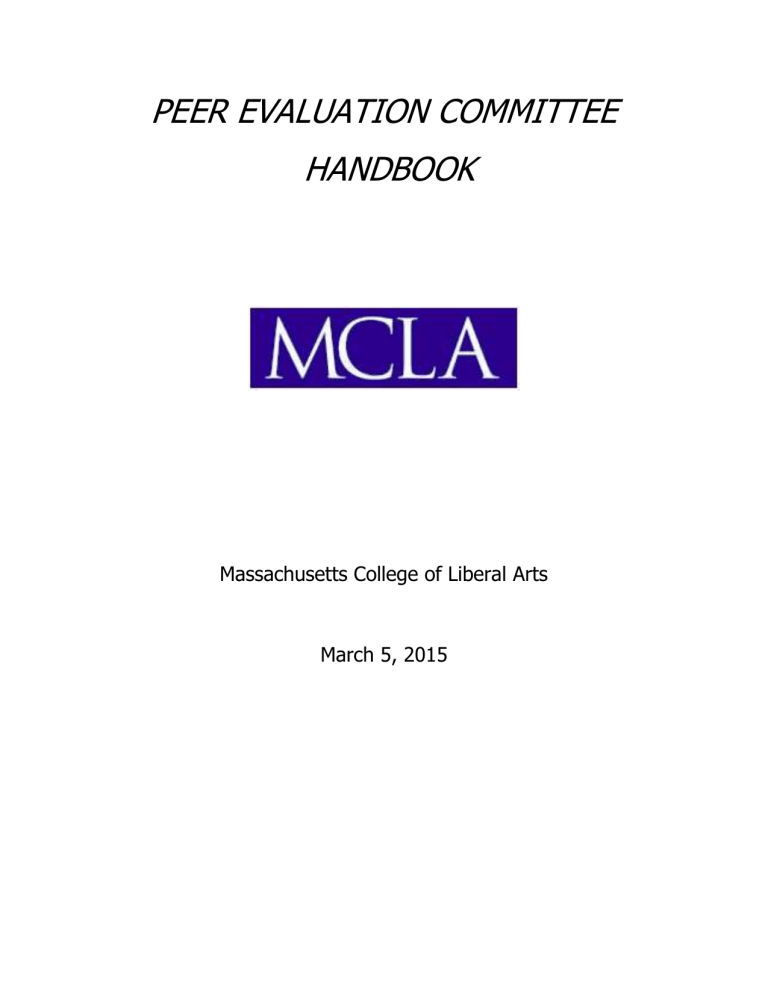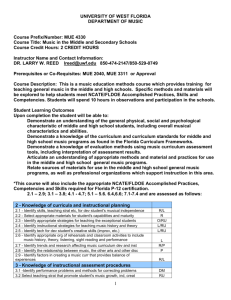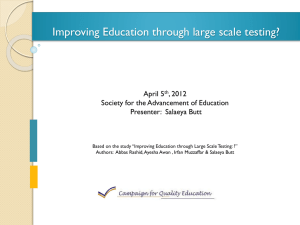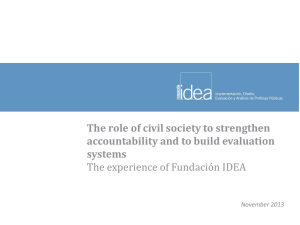peer evaluation committee handbook

PEER EVALUATION COMMITTEE
HANDBOOK
Massachusetts College of Liberal Arts
March 5, 2015
TABLE OF CONTENTS
Message to MCLA Faculty
The Peer Evaluation Process
Overview of the PEC’s Activities
Eligibility for Service
The PEC Evaluation for Reappointment, Tenure, Promotion
Classroom Visits (for faculty)
The Committee’s Evaluation
Checklist for Reappointment, Tenure, Promotion
The PEC Evaluation of the Department Chair
Overview of Chair’s Responsibilities
Candidates Right to Respond
Considerations of Fairness
Additional Considerations
Some Cautionary Notes about SIR II’s
Special Thanks
Appendices
8
9
10
11
2
3
3
4
4
4
5
7
12
13
14
1
A Message to MCLA Faculty
This is the second edition of the Peer Evaluation handbook for MCLA Faculty. This handbook is modeled after the PEC Handbook used at Bridgewater State University. A concerted effort was made to develop a comprehensive guide but some sections may need to be improved in future additions. I hope you will find this handbook helpful.
The PEC Handbook is both a guide and a summary of the applicable provisions found in the collective bargaining agreement. The agreement is posted on the MSCA website at www.mscaunion.org
. This document was prepared by Michele Ethier. Dana Rapp and Deb Foss provided editorial assistance with the first edition. While I believe that the statements contained in this handbook are accurate, questions, comments, and clarifications for future editions are welcome.
Relevant documents can be found in the appendices of this handbook.
All sections and page references contained in this handbook refer to the 2014-2017 Agreement.
2
PEC Handbook
The Peer Evaluation Process
The Peer Evaluation Committee (PEC) evaluates faculty and librarians for reappointment, tenure and promotion. The PEC also evaluates the Department Chair. The relevant portion of the contract is Article VIII. The web link is: http://mscaunion.org
.
PEC’s are required for reappointment, promotion, tenure, and tenure with promotion (but PEC is for tenure.) PEC’s are not required for reduced submissions 1 st , 3 rd , 5 th year.
Evaluators must vote: Members of the PEC must vote. Members cannot abstain.
Librarian Evaluations: Library Peer Evaluation Committee evaluates Librarians every 3 rd year of service beginning in the 2 nd year unless otherwise directed by the VP.
The PEC consists of two tenured members of the department in which a candidate is being evaluated, the PEC is elected by the tenured and tenure-track members of the department as a whole. A third member of the committee is chosen by the candidate from among the tenured members of the department. When, because of department size or absences, a sufficient number of tenured department members cannot be chosen from the department, committee members are chosen by the candidate from cognate departments. Department Chairs or the
Director of Library Services will consult with the Vice President for Academic Affairs (VPAA) and the MSCA Chapter President regarding selection of appropriate cognate departments.
In some circumstances, the department may, at its discretion, establish two PECs (but not more than two). This may occur when a department has twelve or more full-time members and eight or more evaluations in a single year (reappointments, promotions, or tenure). In this event, the persons to be evaluated by each committee should be assigned by lottery.
Overview of the PEC’s Activities
The Department Chair or Director of Library Services transmits to the PEC the materials submitted by the candidate. The first order of business for the PEC is to select a chair. Each member of the committee conducts a classroom visit and completes Appendix D-1 (a); more information is given in the section on “Classroom Visits” below. In all cases, the committee reviews the candidate’s portfolio, records its comments on appendix D-2(b) for faculty or appendix E-1(b) for librarians, and transmits a copy of its evaluation and recommendation to the candidate. The candidate has the right to submit a written response within 10 calendar days. See section on “The Committee’s Evaluation.”
Thereafter, the chair of the committee submits the committee’s evaluation and recommendation, together with all materials used in the evaluation and any written response from the faculty member or librarian. For reappointment or promotion, the committee submits its evaluation to the Department Chair/Director of Library Services. For tenure, the committee
3
submits its evaluation to the Committee on Tenure through the Vice President of Academic
Affairs. The timelines for PEC actions on reappointment, tenure, promotion, and Department
Chair evaluations are specified in the annual Personnel calendar.
Eligibility for Service on the PEC
Only tenured MSCA unit members are eligible to serve on the PEC, tenure at any rank.
Unit members on sabbatical or other leave only during the Spring may serve on PECs since the business of these committees will conclude during the Fall semester. Unit members on sabbatical for a full year or in the Fall semester may not serve on PEC’s.
Unit Members who serve on the PEC of a faculty member may not also serve on the tenure committee of that individual.
Department Chairpersons may not serve on any PEC, including PECs in other
departments.
A candidate for promotion may not serve on a PEC.
Members of the college-wide Committee on Promotions may not serve on the PEC of any candidate for promotion. They are not prohibited, however, from serving on the
PEC of individuals who seek reappointment or tenure.
A candidate for Post-Tenure Review can serve as the third member of a PEC if she/he is not evaluating the Department Chair. A person undergoing post-tenure review may not serve on the PEC for the evaluation of a chair who is observing him/her.
The PEC Evaluation for Reappointment, Tenure, and Promotion
Classroom Visits (for faculty)
Each PEC member is responsible for visiting a class (not necessarily the same class) and completing a separate Appendix D-1 (a). PEC members are not required to visit all the candidate’s classes. Candidates and evaluators should meet prior to the class so that the evaluators have an overview of the class and class materials. Unannounced visits are inappropriate.
PEC members should review the syllabus and other class materials in advance. It is helpful to review and be aware of the criteria on Appendix D-1(a). These include issues of pedagogy, teaching effectiveness, and classroom dynamics, as well as content.
PEC members should attend the entire class on that day and meet with the faculty member after the class to discuss the day’s outcomes and gain the faculty member’s perspectives. The
Post Observation Visit (where PEC member meets with the candidate to discuss the class) is
4
done prior to completing D1a or D1b (classroom observation or distance observation form.) A one-hour visit is sufficient for classes lasting more than an hour. Unless invited to do so by the professor, PEC observers should avoid participating directly in classroom activities.
The Committee’s Evaluation
The committee as a whole completes a single Appendix D-2(b) for faculty or Appendix E-1(b) for librarians based on the PEC members’ classroom visits (for faculty) and the materials submitted for review. Each committee member should read and review the entire dossier of each candidate. Comments are required in each of the following areas of responsibility:
Teaching effectiveness (for faculty).
Academic advising (for faculty). If a faculty member has more than 30 advisees, she/he can elect to have those considered under category II of Continuing
Scholarship.
Effectiveness in performing assigned responsibilities (for librarians).
Effectiveness in rendering assistance to students, faculty, and the academic community (for librarians).
Continuing scholarship.
Professional activities.
Alternative assignments (if any).
For professional activities and responsibilities the PEC conducts its evaluation according to the criteria selected by the candidate on Appendix A-1 or A-2. These are as follows:
Continuing Scholarship
Candidates are required to select one criterion for continuing scholarship but may choose to select more. The evaluation of the candidate’s scholarship must be confined to the
criterion/a selected and must not critique the candidate’s choice of criterion/a.
Contribution to the content of the discipline (for faculty); contribution to the content and pedagogy of the discipline through the development of library programs or library services (for librarians).
Participation in or contribution to professional organizations and societies.
Research as demonstrated by published or unpublished work.
Artistic or other creative activities.
5
Work toward the terminal degree or relevant post graduate study.
Other, as explained by the candidate
Example: If the faculty member has done credible in-house research that meets a need, it cannot be critiqued for not being published.
Professional Activities
Candidates are required to select one criterion for professional activities but may choose to select more. The evaluation of the candidate’s professional activities must be confined to the criterion/a selected and must not critique the candidate’s choice of criterion/a.
Public Service.
Contributions to the professional growth and development of the College
Community. (For faculty, this may include academic advising of students in excess of 30 as assigned at the beginning of the semester).
Other, as explained by the candidate.
Example: If the faculty member only selects “public service,” s/he cannot be negatively judged if there is no evidence of contributions to the professional growth and development of the college community.
Alternative Assignments
This is only considered if the candidate has an alternative assignment and, if so, the individual must be evaluated in the role of:
Chair.
Alternative Professional Responsibilities.
Professional development program.
Other, as explained by the candidate.
Alternative Assignment: Applies to anyone who receives a course reduction for any reason.
6
Evaluation Standards
The basis of the evaluation is “professional quality demonstrated with reference to each of the applicable criteria.” The comments in the evaluation memo must be confined to the opinions of the
majority
of the committee, and they must be based on the official record represented by the classroom visits and/or the materials submitted by the candidate.
Comments reflecting minority opinions and minority reports are not permitted. The written PEC report is signed by the PEC Chair, but must represent the collective deliberations of all members of the PEC.
When recommending in favor of reappointment, promotion, or tenure, the PEC has an obligation to provide clear and convincing arguments in favor of the action. When recommending against reappointment, promotion, or tenure, the PEC has an obligation to provide full and complete reasons for its recommendation.
In its report, the PEC should include
The recommendation.
The names of the committee members.
The numerical vote, but not the vote associated with each member.
A statement that the evaluation was conducted in compliance with the Agreement.
Completed evaluations are transmitted to
The Department Chair for reappointment and promotion
The Committee on Tenure through the VPAA for tenure
Checklist for Reappointment, Tenure, and Promotion o Department elects two tenured members to the PEC by September 30. o PEC meets to elect the PEC chair. o Candidate submits materials to Department Chair/Director of Library Services including Appendix A-1 or A-2, B-2 (the Comprehensive Resume), and supporting materials. o PEC obtains candidate’s materials from Chair/Director of Library Services. o For faculty, each PEC member visits one class for the purposes of evaluating teaching effectiveness, and completes Appendix D-1 (a), the Classroom Visitation
Form. o PEC invites candidate to meet with them prior to writing the report.
7
o PEC writes and signs the report using Appendix D-2(b) for faculty, or Appendix E-1
(b) for librarians. o PEC shares report with candidate, who has 10 days to respond (reappointment or promotion), or 7 days to respond (tenure).
After 7 or 10 days, the PEC submits its reappointment or promotion evaluation to the
Department Chair, or its tenure evaluation (if applicable) to the Committee on Tenure through the VPAA, along with documentation and the candidate’s response, if any.
The PEC Evaluation of the Department Chair
The PEC conducts the Chair’s evaluation. Chairs are evaluated during the second and third years of the first term, and during the third year of any subsequent consecutive terms. The committee evaluates the Department Chair’s performance of the duties and responsibilities described in Section A of Article VI. In conducting the evaluation, the committee solicits evaluations from other members of the department, including day visiting lecturers, using
Appendix D-4, which asks each person to rate the Chair’s performance in each area of responsibility as Superior, Adequate, Inadequate, or Not applicable.
After collection of the D-4 forms and committee discussion, the chair of the PEC writes the evaluation. This evaluation should be a digest of the discussion, not verbatim comments from individual PEC members or department members. As always, remarks should be confined to contract criteria relevant to the Chair’s duties.
This report should include:
The names of the committee members.
A record of votes cast, but not the vote associated with each PEC member. PEC members must vote. They cannot abstain.
A statement that the evaluation was conducted in compliance with the
Agreement.
Completed evaluations are transmitted to the VPAA.
8
Overview of Chair’s Responsibilities
The responsibilities of chairs appear throughout the collective bargaining agreement. A core list is found in Article VI, Section A. Below is an abbreviated version of that core list. Consult
Article VI, Section A, for a complete description of these responsibilities.
Note: the chair is not responsible for determining if a faculty member may use his/her own textbook in a class. That decision lies with the president of the college or other managerial employee designated by the president. Under no circumstances shall a chair be required to sign off on an ethics disclosure form regarding faculty using their materials in classes.
1.
Provide for the scheduling of courses and other departmental functions.
2.
Make recommendations regarding the curriculum.
3.
Assist in program reviews.
4.
Assist in the recruitment of faculty.
5.
Request supplies, equipment, library holdings, etc.
6.
Maintain communication with students and faculty regarding departmental matters.
7.
Oversee advising; assign student advisees on a fair and equitable basis; evaluate faculty with respect to the quality of advising.
8.
Conduct faculty evaluations.
9.
Advise faculty of the receipt of a substantial complaint.
10.
Seek to resolve student/faculty complaints and other intra-departmental disputes informally.
11.
Prepare annual and long-range academic and budgetary plans.
12.
Maintain an inventory of departmental equipment and develop long-range plans for its replacement.
13.
Meet with the Vice President , any appropriate dean or deans, department members, and departmental committees to coordinate activities
14.
Make recommendations regarding class sizes
15.
Supervise clerical and non-unit staff. (Consult Human Resources concerning relevant provisions of the AFSCME Agreement).
16.
Carry out other duties assigned by the Vice President.
9
Candidate’s Right to Respond
The faculty member has the right to respond to any written evaluation conducted by any evaluative body.
The PEC’s evaluation: 10 calendar days to respond
Chair’s evaluation: 10 calendar days to respond
Vice President’s evaluation: 7 calendar days to respond
For promotion and tenure, COP and COT evaluations are transmitted to the faculty member by the Vice President: 7 calendar days to respond.
“Days” begin with the date the candidate receives the evaluation (candidate signs it, indicating it has been received and read.)
The Faculty Association recommends that the candidate respond to a negative evaluation.
Definition of Day: Deadlines following Saturday, Sunday or holiday are moved to the next day. This applies to both evaluation deadlines and the candidate’s right to respond.
10
Considerations of Fairness
Both candidates and evaluators have a responsibility to be fair to each other. It is important that both share an understanding of the Agreement, the criteria of evaluation, and the evaluation process. A culture of shared expectations at MCLA will enhance the probability that personnel actions will be productive, respectful, and collegial.
A.
Scholarship
Evaluation by the PEC requires the exercise of academic judgment. Scholarship or pedagogy can vary across departments or even within a single department, so effort is needed to understand disciplines that are different from one’s own. In Article VIII the
Agreement states that:
“In evaluating each member of the faculty, it shall be the responsibility of those charged with doing so to assess the quality, significance and relevance of that faculty member’s continuing scholarship.”
Please note that quantity is not an evaluative measure. What constitutes scholarship is open to interpretation and may involve both traditional, nontraditional and unconventional “products.”
B.
Contractual Criteria Only
Be objective and open-minded. Although it may seem obvious, remember to address only the contractual criteria and not extraneous matters such as personal interactions or department issues. Use only documentation provided in the portfolio or gathered through classroom visits. Evidence obtained or provided from other sources cannot be used in the evaluation. Evaluations should not include incidental observations.
C.
Organization
A candidate’s file should be clearly organized and include one or more of the following: a table of contents, tabs, sections, dividers, numbered pages. The Agreement does not address how to organize a portfolio. There is no one right way.
D.
Missing Documents
A candidate should provide a full and complete portfolio. It is understood that evaluators may request missing documents (via appropriate channels or personnel) in order to make a clear and convincing, or full and complete, recommendation.
Evaluators may not arbitrarily decide to request one or two missing documents from one
11
candidate but not from another candidate. There is no limit on the number of appropriate documents that can be requested.
E.
Categories
It shall be the responsibility of any member of the bargaining unit who is a candidate for reappointment, tenure, or promotion to verify and demonstrate that he/she has fulfilled the criteria that pertain to the personnel action for which he/she is a candidate. In applying these criteria, it should be understood that Massachusetts State Universities are primarily teaching institutions.
F.
Definitions and Standards
In Article VIII, of the Agreement, it states, “it being the understanding of the parties that for promotion to each higher rank, a higher order of quality may properly be demanded.”
What is the higher standard? What is the standard? What is the lower standard? These are questions that the contract does not answer.
G.
Professional Quality (Article VIII, A4): Professional quality is not defined in the contract.
H.
Meritorious Performance (Article VIII, Article xx): is not defined in the contract.
Additional Considerations:
1.
The narrative is an optional document (but highly recommended).
2.
Candidates cannot be compared.
3.
Quotas are not allowed. Quotas by rank are not allowed.
4.
No faculty member should serve on an evaluation committee or participate in the conduct of an evaluation if to do so would constitute a conflict of interest or the appearance of a conflict of interest.
5.
All evaluators are bound to keep confidential all aspects of an evaluation.
6.
The absence of student evaluations from the record of the following semesters shall not be considered either positively or negatively when evaluating a faculty member’s teaching effectiveness: Fall 1999, Spring 2000, Fall 2000, Fall 2003,
Spring 2004, Fall 2004, Spring 2005, Fall 2005.
7.
For Positive Recommendation – Clear and convincing reasons (Article VIII).
8.
For Negative Recommendation – Full and complete reasons (Article VIII).
12
Some Cautionary Notes About SIR II’s
(See MSCA Perspective)
ETS will no longer process SIR II forms where 6 or fewer students are enrolled. The scores are not valid with an N of 6 or less. The Administration will not distribute evaluations to courses with 6 or fewer students. Evaluators must hold harmless if this applies to the candidate.
Evaluators should be cautious when drawing conclusion about SIR II Evaluation data.
The MSCA is pursuing 3 consolidated grievances alleging procedural violations in the misuse and inconsistent use of SIR II student evaluation forms.
SIR II’s cannot be used as the sole or only determinant of teaching effectiveness. Course materials, classroom observations by the chair and peers and the self evaluation are equally
important components.
The SIR II student evaluations are NOT more important than other types of evaluation.
Comparison Group of 4 Year Institutions
Compared to 19 other institutions not identified
There are 2,474 four year institutions of higher education in the United States. The sample size of 19 is only .77%
The MSCA maintains that the SIR II comparison group should not be described as “peers”,
“national peers”, “peer institutions”, “comparable institutions”, “similar institutions”, etc.
The 19 institutions (unnamed and unidentified) may be substantially different from the state universities in Massachusetts.
Comparative does not mean comparable!
SIR II’s do not indicate teaching effectiveness as excellent, very good, good, average, moderate, or low. These terms were rejected by the designers of SIR II and should not be used in your evaluative statements regarding SIR II’s.
*Beware the Micrometer Fallacy: Don’t make decisions or draw conclusions based on small differences.
This data was fully discussed in the MSCA Perspective’s special issue for State University Faculty
and Librarians undergoing Personnel Action. (Quoted here with permission of the MSCA.)
13
This document was prepared by Michele Ethier, Department of Sociology, Anthropology, and Social work at MCLA.
Special Thanks
Special Thanks to Bridgewater State University for the use of their model, to Dana Rapp and Deb Foss for editorial assistance with the first edition, to Maria LaValley for typing and retyping this document, to Pat Markunas and the Employee Relations Committee
(ERC) for printed guides sponsored by MSCA.
14







